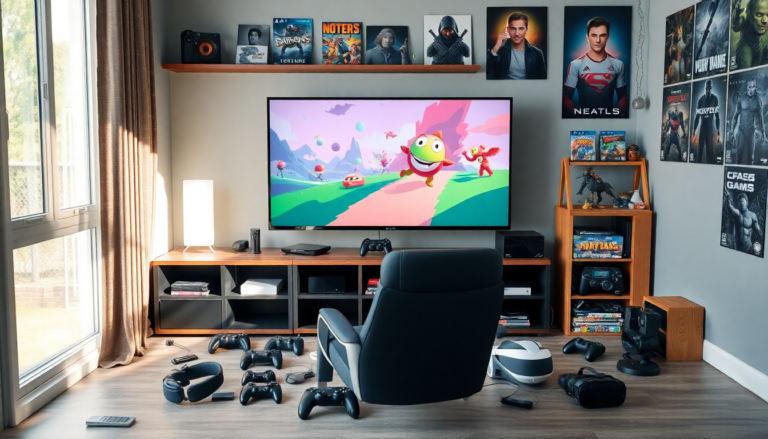Argomenti trattati
The gaming hardware market is experiencing a remarkable transformation, driven by rapid technological advancements and shifting consumer preferences. Today, the gaming landscape is a vibrant blend of mobile gaming, eSports, and cloud technology, reshaping how players engage with interactive entertainment. But what does this mean for the future of gaming? Let’s dive into the growth of the gaming hardware market, explore the key trends, and uncover the factors propelling its evolution.
Current Market Insights
As we step into 2024, the global gaming market has hit an astonishing valuation of $230.96 billion, with projections suggesting it could soar to $349.89 billion by 2032. This growth translates into a compound annual growth rate (CAGR) of 5.39% from 2025 to 2032. Notably, mobile gaming has claimed the largest share, accounting for a remarkable 49% of total market revenue. Isn’t it fascinating how our access to gaming experiences has evolved, especially through the convenience of smartphones?
Revenue from mobile gaming alone topped around $92 billion in 2024, while console and PC gaming brought in $51 billion and $43 billion, respectively. This distribution underscores the diverse nature of gaming platforms and highlights the crucial role hardware plays across the board. As gamers demand high-quality experiences, manufacturers are racing to innovate, pushing the boundaries of hardware development to meet evolving expectations.
Key Drivers of Growth
The hardware segment is a powerhouse in driving market growth, capturing a dominant revenue share of 65.03% in 2022. As gamers increasingly seek superior performance and immersive experiences, innovation in hardware components like high-end graphics processing units (GPUs), cooling systems, and specialized peripherals is surging. These advancements collectively enhance user experiences, ensuring gamers achieve optimal performance levels. But what does this mean for the everyday gamer?
Cloud gaming technology is also revolutionizing the gaming landscape by reducing the need for frequent hardware upgrades. This democratization of gaming opens doors to high-quality experiences, especially in emerging markets where the costs of hardware can be a barrier. With the rollout of 5G networks, cloud gaming performance is improving, enabling console-quality gaming on mobile devices through lower latency and better connectivity. How exciting is it to think that you could enjoy premium gaming on your phone?
Emerging Technologies and Market Trends
Looking ahead, technologies like virtual reality (VR), augmented reality (AR), and artificial intelligence (AI) are set to redefine the gaming experience. The demand for specialized hardware tailored for VR and AR is on the rise, as these immersive technologies require high-resolution displays and precise motion tracking. With manufacturers investing heavily in these innovations, the gaming landscape promises personalized and secure experiences. Are you ready to immerse yourself in a whole new world?
Moreover, the integration of AI is enhancing hardware capabilities, optimizing performance, and personalizing user experiences. More manufacturers are incorporating AI-specific processors into gaming devices, allowing for real-time optimization that gives gamers a competitive edge. This trend is especially relevant as mobile gaming continues to grow, fueled by the widespread adoption of smartphones and affordable internet in emerging markets.
Challenges and Considerations
Despite the promising outlook, the gaming hardware market does face hurdles. High development costs for cutting-edge hardware and AAA games can limit accessibility for price-sensitive consumers, impacting overall market growth. Infrastructure issues in emerging economies also pose challenges, as strong connectivity is essential for modern gaming experiences. What might this mean for the future of gaming in these regions?
Furthermore, there are growing concerns about gaming addiction and related health issues that could lead to regulatory challenges, especially for younger players. Governments worldwide are starting to implement regulations aimed at managing gaming time and content access for minors, which could significantly influence market dynamics. How will the industry adapt to these changes?
In conclusion, the gaming hardware market is on the brink of continued growth, spurred by technological advancements and evolving consumer preferences. As we approach a market valuation of $350 billion by 2032, companies that prioritize innovation while ensuring accessibility will be best positioned to seize significant opportunities. The convergence of mobile gaming, cloud technology, and premium hardware not only enhances gaming experiences but also extends its influence into sectors like education and training. Isn’t it fascinating to think about the endless possibilities?
Strategic investments in emerging technologies and a keen focus on consumer preferences will be critical for gaming hardware companies as they navigate this dynamic landscape. Are you ready to embrace the future of gaming?

